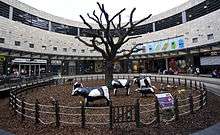Concrete Cows

The Concrete Cows in Milton Keynes, England are an iconic work of sculpture, created in 1978 by the Canadian artist Liz Leyh.[1] There are three cows and three calves, approximately half life size.
The Cows are constructed from scrap, skinned with fibre glass reinforced concrete donated by a local builder.[2]
Context
The artist was an "artist-in-residence" in the early days of Milton Keynes and part of her role was to lead community participation in art. The Cows was one of a number of pieces created during her stay.[2] Other examples of her work here include The Owl and The Pussy Cat at Netherfield and a concrete mural near the leisure centre at Stantonbury. They were originally constructed at Stacey Hill Farm near Wolverton, where she had set up her studio. The base armatures were metal, with chicken wire used to create the general shape, then stuffed with newspaper. The original colouring of the cows was achieved using dyes. Some cows were brown. It is only through the council painting the cows that the uniform black and white has appeared. The artist also ensured that each cow had a heart shape used as part of the pattern on the cow skin.
Later commentators have interpreted it as an example of conceptual art: the artist poking fun at the preconceived notion of the new city, held by commentators who had never seen the place, that it would consist entirely of concrete pavements where once there were fields, and where its deprived children would need models to know how real cows once looked.[3] The reality of course was different: Milton Keynes Development Corporation was building "a city in the forest", with substantially more open green space than found in traditional cities. Furthermore, there are real farms with real cows within 2 miles (3 km) of the site, and the cows are currently located in a real field.
Response
On their site in a public park, the Cows have suffered many indignities – though it could be argued that these were consistent with their conceptual origins. Sometimes they have simply been vandalised,[4] while at other times they have been painted pink, become zebras,[5] become skeletal,[6] had pyjama bottoms added,[7] have been beheaded[7] in the style of Damien Hirst, have acquired BSE (mad cow disease) graffiti,[7] had one of the calves kidnapped (with ransom notes to the local papers).[5] One of the Cows briefly enjoyed the services of a papier-mâché bull. When UK Culture Minister Kim Howells referred to modern art trends as "conceptual bullshit",[8] the Cows acquired concrete cow-pats. Local legend has it that the ears of the Cows have shrunk over the years, as more protruding versions have been knocked off by enthusiastic riders.

Significance
In a programme, The Sculpture 100, made for Sky Television in December 2005, the Concrete Cows were included in a list of the 100 most influential works of twentieth-century open-air sculpture in England. The list also includes another piece in Milton Keynes: Triple Starhead by Paul Neagu (in Furzton).
In popular culture
The home supporters stand at Milton Keynes Dons F.C. is known as "The Cowshed". The team mascots are two pantomime-style cows named "Donny" and "Mooie".
Actor Russell Crowe joked about the cows in 2007 while promoting the movie 3:10 to Yuma.[9] The cows appear in Charles Stross' story The Concrete Jungle, and in Mark Wallington's Destination Lapland, where he marked seeing them a highlight of his passing visit.
Location

The Cows were made at Stacey Hill Farm, now the site of the Milton Keynes Museum.[10] and originally located at a parkland site in Bancroft. They have subsequently resided at the National Hockey Stadium and INTU Milton Keynes, beside the Central Milton Keynes Shopping Centre.[11] In Spring 2016 they were moved to MK Museum - which is where they originally started out as a temporary exhibit.[10] [11] However the replicas (made by Bill Billings) in Bancroft are perhaps better known and are sited next to the A422 (Monks Way) between V5 Great Monks St. and V6 Grafton St.) where it passes under the West Coast Main Line, near its junction with the A5. Direct access on foot or by bike is possible by redway.
The nearest rail stations are Milton Keynes Central and Wolverton. MK Metro buses 5 and 6 between Bletchley, Central Milton Keynes and Wolverton call at near-by bus stops on each side of Monks Way near the junction with H3's northern carriageway and Octavian Drive. If approaching on foot or by bike from these stops, a stream separates the cows from the eastern (Octavian Rd) side of H3. There is a bridge over the stream next to the southern carriageway of H3, and an underpass links this bridge to the cows' field.
See also
- Harold F. Clayton — another sculptor of cows
- CowParade — a festival of cow sculpture
References
- ↑ "The Concrete Cows". Milton Keynes Heritage Association / Milton Keynes Museum. Retrieved 17 March 2008.
- 1 2 "The Reunion - A programme reuniting the people who created Milton Keynes". BBC Radio 4. 22 April 2007. Retrieved 13 July 2007.
- ↑ The Sculpture 100 (saved at Archive.org)
- ↑ "Cows vandalism is udder disgrace". BBC News. 3 September 2002. Archived from the original on 3 May 2008. Retrieved 13 July 2007.
- 1 2 Places to visit in MK: Concrete Cows
- ↑ Milton Keynes cows to stay as skeletons for Halloween
- 1 2 3 Concrete Cows
- ↑ Minister attacks Turner art
- ↑ Sexton, Anna (17 September 2007). "Stone the Crowe's!". Milton Keynes Citizen. Retrieved 3 December 2008.
- 1 2 Milton Keynes' concrete cows on the moo-ve to Milton Keynes Museum
- 1 2 Milton Keynes concrete cows return to museum
External links
- 360° animated picture of the Cows, from BBC Three Counties
- New Bradwell School article on the cows, part of the Open University Clutch Club website
Coordinates: 52°03′04″N 0°47′43″W / 52.051085°N 0.795195°W